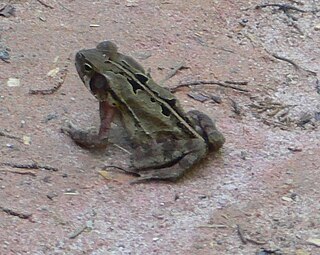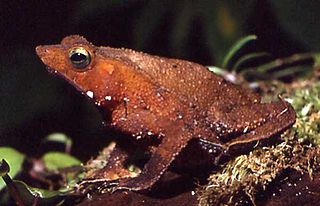
The cane toad, also known as the giant neotropical toad or marine toad, is a large, terrestrial true toad native to South and mainland Central America, but which has been introduced to various islands throughout Oceania and the Caribbean, as well as Northern Australia. It is a member of the genus Rhinella, which includes many true toad species found throughout Central and South America, but it was formerly assigned to the genus Bufo.

Osteocephalus is a genus of frogs, the slender-legged tree frogs, in the family Hylidae found in the Guianas, the Amazon Basin, Venezuela, Colombia, southeastern Brazil, and north-eastern Argentina. Males are warty, while females are smooth.

Phrynopus is a genus of frogs of the family Strabomantidae. Their common name is Andes frogs. They are endemic to Peru and inhabit the upper humid montane forest and supra-treeline grassland in the Cordillera Oriental, with one record from the Peruvian Cordillera Occidental.

A true toad is any member of the family Bufonidae, in the order Anura. This is the only family of anurans in which all members are known as toads, although some may be called frogs. The bufonids now comprise more than 35 genera, Bufo being the best known.
Rhinella chrysophora, sometimes known as the Rio Viejo toad, is a species of toad in the family Bufonidae. It is endemic to the Cordillera Nombre de Dios on the Atlantic versant in north-central Honduras.
Rhinella arborescandens is a species of toad in the family Bufonidae. It is endemic to Peru and only known from its type locality near Mendoza, northern Cordillera Central, in the Amazonas Region. It is unusual among Rhinella toads because it is arboreal, hence the specific name arborescandens, derived from Latin arbor for tree and scando meaning to climb.

Rhinella crucifer is a species of toad in the family Bufonidae. It endemic to Brazil and known from the Atlantic Forest of eastern Brazil between the states of Ceará in the north and Rio de Janeiro in the south. Common name striped toad has been coined for it. "Rhinella pombali" is a hybrid between Rhinella ornata and this species.
Sclerophrys fuliginata is a species of toad in the family Bufonidae. The specific name fuliginata is Latin for "sooty", in reference to the species' appearance of a more or less diffusely uniform exterior color and pattern. It is also known as the Shaba Province toad or sooty toad. It is found in the southern Democratic Republic of the Congo, southeastern Tanzania, and northern Zambia.

Rhinella jimi is a species of toads in the family Bufonidae. It is endemic to northeastern Brazil and known between Bujaru in northeastern Pará and Maranhão in the north, south to Bahia and Vitória, Espírito Santo. Prior to its description in 2002, it was confused with Rhinella schneideri. The specific name jimi honors Jorge Jim, a Brazilian herpetologist. Common name Jimi's toad has been coined for it.

Incilius leucomyos is a species of toad in the family Bufonidae. It was described in 2000 and is endemic to the Atlantic versant of the north-central Honduras.
Rhinella multiverrucosa is a species of toad in the family Bufonidae. It is endemic to Peru. Its natural habitat is subtropical or tropical moist montane forests. It is threatened by habitat loss.

Rhinella poeppigii is a species of toad in the family Bufonidae that is known from the eastern Andean slopes of Ecuador, Peru, and Bolivia, as well as from Serranía de Sira in Amazonian Peru. Its distinctiveness from Rhinella marina has been debated, but it is currently accepted as a valid species. It is named after Eduard Friedrich Poeppig, German botanist and naturalist who made scientific expeditions to South America.

Rhinella proboscidea is a species of small South American toad in the family Bufonidae, common in the Amazon rainforest. It is the only species known to practice reproductive necrophilia.

Rhinella festae is a species of toad in the family Bufonidae. It is found in Ecuador and Peru. Its natural habitats are subtropical or tropical moist lowland forests and subtropical or tropical moist montane forests. It is threatened by habitat loss.
Rhinella lindae is a species of toad in the family Bufonidae. It is endemic to Colombia and known from its type locality, Murri in the municipality of Frontino, and from Las Orquídeas National Natural Park, both on the western slope of the Cordillera Occidental, Antioquia Department. The specific name lindae honors Linda Trueb, an American herpetologist. However, common name Murri beaked toad has been coined for this species.
Rhinella ruizi is a species of toad in the family Bufonidae. It is endemic to the Cordillera Central in Antioquia, Colombia. The specific name ruizi honors Pedro Miguel Ruiz-Carranza, a Colombian herpetologist.
Atelopus pyrodactylus is a species of toad in the family Bufonidae. It is endemic to Peru and only known from its type locality in the northern section of the Río Huallaga basin, Department of San Martín, on the eastern slope of the Cordillera Central. The specific name pyrodactylus refers to the light orange fingers and toes of this frog.
Osteocephalus castaneicola is a species of frog in the family Hylidae. It is found in lowland Amazonia of northern Bolivia, adjacent southeastern Peru, and western Brazil. It breeds in water-filled fruit capsules of the Brazil nut, a characteristic also alluded to in its specific name castaneicola derived from the Latin castanea, the root of the vernacular name castaña for the Brazil nut, together with the Latin colō meaning "to inhabit".

Pristimantis ashaninka is a species of frog in the Craugastoridae family. It is found in the Pui Pui Protection Forest in central Peru. It is 23 to 26 millimeters long, and is characterized by containing small conical tubercles in its skin, giving a spiny appearance, and by having no tympanic membrane. The species was described in 2017 after morphological and genetic analyses and was named Pristimantis ashaninka in honor of the indigenous people Asháninka, who live in the regions near the protection forest. The species was listed by the International Union for Conservation of Nature as a least-concern species. There is still no information about its behavior and/or reproduction, but it is assumed that the tadpoles have direct development, as this is a common characteristic of the genus.
Juan Cusi is a Peruvian herpetologist who has led and participated in the identification of multiple amphibian species. His research focuses on diversity, ecology, conservation and taxonomy. He is a Collaborator Researcher at Universidad Nacional Mayor de San Marcos in Lima, Peru. Additionally, Juan Cusi is part of the Edgar Lehr's Lab.













